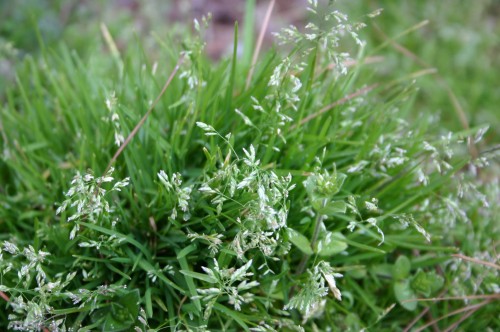





It’s a frustrating situation: you have a thin fescue lawn but you’ve also had problems with annual bluegrass there in previous winters. If you use a pre-emergent (click for sources) to control the bluegrass, you can’t readily plant fescue seed.
Annual bluegrass starts germinating in late summer or fall as soil temperatures fall below 70°F.
You could try either of the two methods below:
Dr. Clint Waltz, UGA Turf specialist:
“Options are limited it these circumstances. The best I can offer is the use of a product containing benefin (Balan) prior to planting. Even then, seeding should be delayed until 6 weeks after treatment. A September 1 pre-emergence application with a mid- to late-October seeding date may provide acceptable control.
“There are several downsides to this program: First, if the application rate is not correct (2 lbs active ingredient per acre) and the chemical is applied too heavy, a six week interval might not be enough and tall fescue inhibition would be expected. Also, seeding fescue in mid- to late-October is not ideal. I like to see tall fescue seeded mid-September when soil temperatures are still warm enough for germination, but once nighttime air temperatures are cooling off. This timing gives the grass the maximum amount of time to grow prior to cold weather.
“Another thought is, if the homeowner has had an acceptable stand of tall fescue this past spring then they may not really need to seed fescue over-the-top. An application of a pre-emergence herbicide will be all that is needed. All too often homeowners over-react to the summer thinning of tall fescue and plan to re-seed.
“If they are going to interseed in the fall, I suggest placing a blanket or door-mat over a representative area and observing the amount of tall fescue that returns once the environmental conditions become favorable. It is common for the tall fescue to quickly return to a healthy thick stand without additional seed.”
Walter Reeves’ thoughts:
If weather permits planting fescue on the first day of September, it MAY be possible to get good germination before annual bluegrass emerges.
Remember: Annual bluegrass starts germinating as soil temperatures fall below 70°F. Click here to check your soil temperature.
The average date in Atlanta of 70 degree soil temperature at a 2 inch depth is in late September. Early-planted fescue would be pretty well established after four weeks in September. Even so, I’d wait until mid-October to apply a pre-emergent.
The label on pre-emergent herbicides may give further information on the application interval after planting fescue.

Copyright © www.100flowers.win Botanic Garden All Rights Reserved